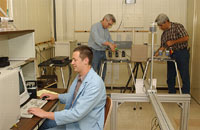| Release date: | August 10, 2004 | |
| Contact: | Judy Graybeal (509) 375-4351 |
|
PNNL Testing Reliability of Radiation Detectors
 PNNL technicians prepare several radiation detectors for reliability testing.
The Department of Homeland Security will use the test results to aid
in the selection of equipment for first-responders.
PNNL technicians prepare several radiation detectors for reliability testing.
The Department of Homeland Security will use the test results to aid
in the selection of equipment for first-responders.(5"x7" 300 dpi image available from PNNL's Photo Library). |
RICHLAND, Wash. – A marathon of testing is under way at the Department of Energy’s Pacific Northwest National Laboratory to ensure that personal radiation detection equipment purchased with Department of Homeland Security funds meets new standards for identifying potential threats.
“These pocket-sized personal radiation detectors and hand-held radiation survey meters play a critical role in the work of law enforcement officers, fire fighters, hazardous material teams and other emergency first-responders,” said PNNL physicist Joe McDonald.
More than 100 instruments, representing approximately 30 different equipment models, will undergo tests of their electrical systems performance, mechanical operations, environmental susceptibilities and radiological sensitivities.
The result will be a Consumer Reports-style publication to be used by agencies purchasing radiation detection equipment with DHS funds. First responders will be able to select equipment based on actual instrument performances, rather than on manufacturer’s claims.
The National Institute of Standards and Technology is coordinating the testing, which is based on criteria that PNNL helped develop for the American National Standards Institute. McDonald chaired the 17-member collaboration of DOE laboratories, NIST, industry and users that developed the standard for personal radiation detectors.
“The group was challenged to develop the standard in record time – only six months – and the pace remains brisk for instrument testing,” McDonald said. Normally, this type of testing would be spread out over a two-year period, “but the need and the threat are present now,” he said.
The PNNL team of five calibration technicians targets Sept. 30 for completion of the DHS testing. Each instrument will undergo both automated and manual test procedures and will be given a pass/fail report, plus a capabilities overview.
McDonald explained that a one-size-fits-all approach doesn’t work for first responders. For instance, the Coast Guard has a keen interest in how equipment survives exposure to salt water and extreme temperatures, while urban-area security personnel look closely at features such as portability, discreetness and detector reaction time.
Realistic conditions are critical to effective testing. Temperature testing will include highs, lows and rapid changes. Equipment will be exposed to vibrations, humidity, radio-frequency and electromagnetic fields. And, while durability tests may not be as extreme as a gorilla tossing luggage, they will evaluate the equipment’s ability to withstand anticipated wear and tear.
Calibration team members believe that the ANSI criteria for performance will ultimately raise the quality of radiation detection devices. “Because manufacturers want their equipment to score well and gain acceptance from government buyers, they have been very interested in working to produce the best possible product,” McDonald said.
“A win for us is not just completing the testing, but also providing information that makes it possible to get reliable equipment in the field as quickly as possible,” McDonald said. “On-time completion will enable DHS to allocate immediate funding for agencies that have urgent business in the line of first response.”
PNNL’s participation in the DHS-funded effort stems from the laboratory’s more than 40 years of health physics experience, including testing and developing standards for radiation detection instruments and management of a fully accredited radiological calibration and standards facility.
Oak Ridge, Los Alamos and Lawrence Livermore national laboratories will conduct similar testing regimes for other types of radiation detection equipment.
Business and public inquiries on PNNL research and technologies should be directed to 1-888-375-PNNL or inquiry@pnl.gov.
PNNL is a DOE Office of Science laboratory that solves complex problems in energy, national security, the environment and life sciences by advancing the understanding of physics, chemistry, biology and computation. PNNL employs 3,800 staff, has a $600 million annual budget, and has been managed by Ohio-based Battelle since the lab’s inception in 1965. www.pnl.gov/news
Additional photos available at:
- Helmholtz coils expose a radiation detector to magnetic fields in three directions.
- The PNNL testing team (from left) Bryan Carter, Phil Smith, Matt Kirchner, Jennifer Kirk and Mark Murphy, uses automated and manual procedures to test personal radiation detection equipment. The instruments receive a pass/fail mark and a capabilities overview.
- Automated monitoring allows simultaneous testing of handheld and pocket-sized personal radiation detection equipment.



